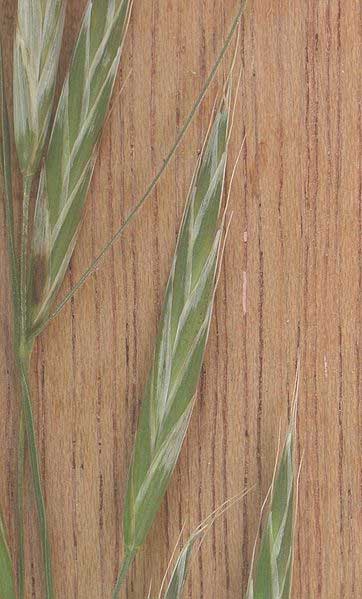
Bromus racemosus (*)
Classification System: APG IV
Superregnum: Eukaryota
Regnum: Plantae
Cladus: Angiosperms
Cladus: Monocots
Cladus: Commelinids
Ordo: Poales
Familia: Poaceae
Subfamilia: Pooideae
Tribus: Bromeae
Genus: Bromus
Subgenus: B. subg. Bromus
Species: Bromus racemosus
Name
Bromus racemosus L.
References
Sp. pl. ed. 2, 1:114. 1762
USDA, ARS, National Genetic Resources Program. Germplasm Resources Information Network - (GRIN) [Online Database]. [1]
Vernacular names
suomi: Myllykattara
Nederlands: Trosdravik
polski: Stokłosa groniasta
Bromus racemosus, the smooth brome or bald brome, is a species of flowering plant in the family Poaceae.[2] It is native to subarctic and temperate Eurasia, and widely introduced elsewhere, including North America, Iceland, the Southern Cone of South America, the Korean Peninsula, Australia, and New Zealand.[1] It grows in alkaline meadows and in waste places.[3]
Description
Bromus racemosus is an annual grass growing 17–60 cm (6.7–23.6 in) tall. Its smooth culms are 1–2.1 mm (0.039–0.083 in) wide at their base. Its brown nodes are minutely to densely pubescent, with these soft and wavy hairs growing up to 1.2 mm (0.047 in) long. Its membranous and glabrous ligules are 0.5–2 mm (0.020–0.079 in) long. Its leaf blades are 2.7–12 cm (1.1–4.7 in) long and 1–3 mm (0.039–0.118 in) wide; the adaxial surface of the blade is densely covered by stiff hairs growing up to 0.8 mm (0.031 in) long, and the abaxial surface is densely covered with stiff hairs which are typically shorter, growing up to 0.6–0.8 mm (0.024–0.031 in). The margins of the blades are smooth or serrulate. Its panicles are 3–8.5 cm (1.2–3.3 in) long and 1–2.5 cm (0.39–0.98 in) wide, with erect to ascending branches which range between scabrous and pubescent. Each branch has a single spikelet, with the lowest inflorescence node having one to four branches. The ovate-lanceolate spikelets are 1.5–2.2 cm (0.59–0.87 in) long, with the rachilla occasionally visible at maturity. The spikelets have six to nine florets. Its glumes are smooth or scabrous, with lower glumes 5.2–6.7 mm (0.20–0.26 in) long and upper glumes 6.2–8.5 mm (0.24–0.33 in) long. The lower glumes have three to five nerves, upper glumes have seven to nine nerves, and lemmas have seven to nine nerves. Its lemmas are 6.5–9.5 mm (0.26–0.37 in) long, and its awns are 3.4–8.5 mm (0.13–0.33 in) long.[4]
Habitat and distribution
In its native Europe, Bromus racemosus occurs in moist meadows and grasslands, though it is threatened by changes in agricultural grassland management.[5] In its introduced habitat in North America, B. racemosus occurs in waste places, fields, roadsides, and gravelly hills in scattered locations throughout the United States and Canada.[4] In South America, the grass occurs in the southern Andes of Argentina and Chile.[6]
References
"Bromus racemosus L." Plants of the World Online. Board of Trustees of the Royal Botanic Gardens, Kew. Retrieved 14 September 2021.
"Bromus racemosus smooth brome". The Royal Horticultural Society. 2021. Retrieved 14 September 2021.
Quattrocchi, Umberto (2006). CRC World Dictionary of Grasses. Common Names, Scientific Names, Eponyms, Synonyms, and Etymology. p. 387. ISBN 9781420003222.
Saarela, Jeffery M. (2008). Barney L Lipscomb (ed.). "Taxonomy of Bromus (Poaceae: Pooideae: Bromeae) Sections Bromopsis, Bromus, and Genea in British Columbia, Canada". Journal of the Botanical Research Institute of Texas. Botanical Research Institute of Texas. 2 (1): 349–350.
Simmelink, Max R and Janssen, John and Schamine, Joop HJ and Weeda, Eddy J (2017). "Habitat and management preference of Bromus racemosus L., a rare species in mesic meadows of Northwest Europe". Tuexenia. 37: 289–312.
Wilson, K.L. and Morrison, D.A. (2000). Monocots: Systematics and Evolution. Monocots: Systematics and Evolution. CSIRO. p. 94. ISBN 9780643063938.
Retrieved from "http://en.wikipedia.org/"
All text is available under the terms of the GNU Free Documentation License

